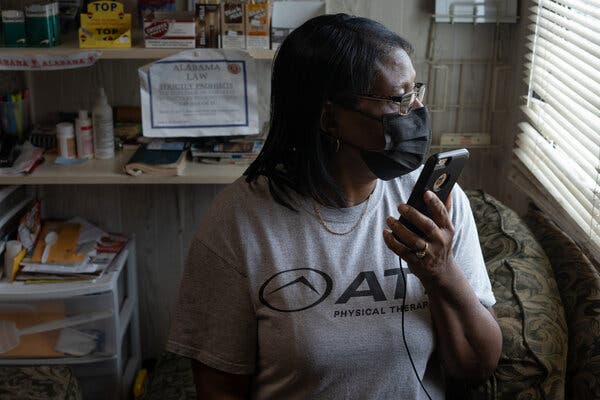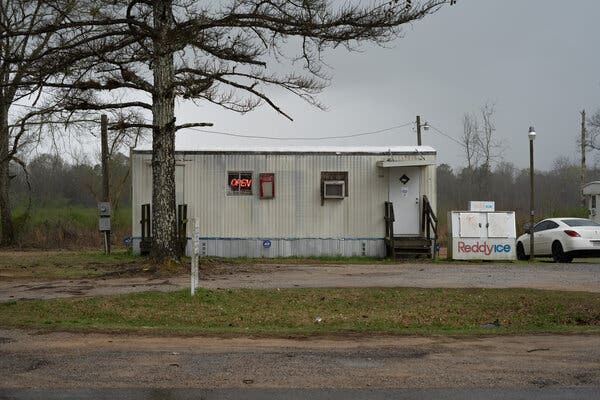Advertisement
Supported by
‘All Hands on Deck’: When Vaccinating Black People Is a Communal Effort
In the face of limited transportation, patchy internet service and threadbare medical care, community leaders in Alabama and Mississippi are trying to shrink the racial disparities in vaccine access.

PANOLA, Ala. — The dog-eared trailer that serves as the only convenience store within 20 miles of this blink-and-you-miss-it rural hamlet, population 144, is more than a place to stock up on life’s essentials. These days the store — or more precisely its proprietor, Dorothy Oliver — has become an unofficial logistics hub for African-American residents seeking the coronavirus vaccine.
Even as vaccine supplies in Alabama have become more plentiful, Ms. Oliver’s neighbors, many of them older and poor, lack the smartphones and internet service needed to book appointments. And if they manage to secure a slot, they may not have a way to get to distant vaccination sites.
Ms. Oliver helps her neighbors snag appointments online and matches them with those willing to make the 45-minute drive to Livingston, the seat of Sumter County and the nearest town offering inoculations. Nearly three-quarters of the residents of the county, which includes Panola, are African-American.
“We’ve got to fend for ourselves because no one else is going to help us,” said Ms. Oliver, 68, a loquacious retired office administrator who spends many of her waking hours on the phone. “That’s the way it’s always been for poor Black people living in the country.”
Across the Southern states, Black doctors, Baptist preachers and respected community figures like Ms. Oliver are trying to combat lingering vaccine skepticism while also helping people overcome logistical hurdles that have led to a troubling disparity in vaccination rates between African-Americans and whites.
Though local leaders have made headway combating the hesitancy, they say the bigger obstacles are structural: the large stretches of Alabama and Mississippi without an internet connection or reliable cellphone service, the paucity of medical providers, and a medical establishment that has long overlooked the health care needs of African-Americans.
As it is, this region has some of the worst health outcomes in the country, and the coronavirus pandemic has disproportionately hit African-Americans, who have been dying at twice the rate of whites.

Alabama is one of the few states that does not require vaccine providers to report data on race, but health officials estimate that just 15 percent of the shots have gone to African-Americans, who make up 27 percent of Alabama’s population and 31 percent of all deaths from Covid-19. Whites, who make up 69 percent of residents, have received 54 percent of the vaccine supply, according to the state data, which is missing details on race for a quarter of vaccine recipients.
In Mississippi, 40 percent of Covid-19 deaths have occurred among African-Americans — a figure comparable to their portion of the population — but just 29 percent of the vaccines have gone to Black residents compared with 62 percent for whites, who make up nearly 60 percent of the state’s population.
The disparities have prompted a flurry of ad hoc organizing across the South that mirrors the increasingly robust get-out-the-vote efforts, which are aimed at surmounting state voting restrictions that critics say dampen minority turnout.
In Cleveland, Miss., Pam Chatman, a retired television journalist has been dispatching rented minibuses to ferry older residents to vaccination sites far from their rural homes. In nearby Greenville, the Rev. Thomas Morris uses his weekly Zoom sermons to assuage the concerns of vaccine skeptics — and then offers up church volunteers who book appointments for the flip phone set. And in central Alabama, Dr. John B. Waits, who oversees a constellation of nonprofit health clinics serving the poor, has been sending out mobile vaccinators to reach the homebound and the homeless.
“It’s all hands on deck because this is a life-and-death situation,” said Dr. Vernon A. Rayford, a pediatrician and internal medicine doctor in Tupelo, Miss. Dr. Rayford said he had been disappointed by the state’s reliance on a web-based appointment system and drive-through vaccination sites that are clustered in urban areas and white neighborhoods. Although those without internet access can call a state-run number for help booking appointments, many of his patients, he said, give up after spending long stretches on hold. Instead, he encourages them to call his wife, Themesha, who in recent weeks has made more than 100 online appointments on her laptop.
Since returning home to Tupelo eight years ago after a medical residency in Boston, Dr. Rayford said he had been frustrated by the dearth of health care options and entrenched poverty that saddles African-American residents with some of the highest rates of infant mortality, heart disease and diabetes in the country. Mississippi and Alabama are among the dozen states whose Republican-led governments have rejected Medicaid expansion under the Affordable Care Act.
“Until we get a better system, we have to come up with these workarounds, but it gets really tiring,” Dr. Rayford said.
Public health experts say the $ 6 billion for community vaccination sites included in President Biden’s recently passed relief package will go a long way to addressing the problem, and officials in Mississippi and Alabama say they have made considerable progress over the past month in narrowing the racial gap in vaccinations. They say they are expanding vaccine distribution to community clinics and expect access to accelerate alongside increasing supplies of the vaccine made by Johnson & Johnson, which needs only one dose and can be kept at normal refrigeration temperatures, making it easier to distribute in rural areas.
Dr. Thomas Dobbs, Mississippi’s top health official, said 38 percent of all vaccines administered in the second week of March had gone to African-Americans, a milestone he said was accomplished with the help of local organizations. “The options are increasing very quickly and pretty soon people are not going to have to go to a drive-through site,” he said during a news conference last week.
Dr. Karen Landers, Alabama’s assistant state health officer, noted that last week, the Centers for Disease Control and Prevention ranked Alabama among the top 10 states that have vaccinated vulnerable residents — a category that includes racial and ethnic minorities and the economically disadvantaged. But she added that the overwhelmingly rural composition of the state had made the task daunting given Alabama’s limited resources.
“We listen to the criticism, and we are certainly trying to take any elements of truth that are in that criticism so we can better serve our citizens,” Dr. Landers said in an interview.
Still, the logistical challenges remain stark in rural areas of the Deep South, where years of spending cutbacks and a lack of jobs have made life more difficult for the shrinking number of people left behind.
Frances Ford, a registered nurse, has been organizing vaccine appointments in Perry County, Ala., a largely African-American county of 10,000, just north of Selma, where more than a third of all households live in poverty. Ms. Ford, who runs the nonprofit organization Sowing Seeds of Hope, said many older residents were terrified of medical emergencies, even more so at night, given that there are just two ambulances to serve the county’s 720-square miles. The closest critical care hospital, in Tuscaloosa, is nearly 60 miles away.
Those who don’t drive and need routine medical care have to rely on a single van operated by the state to take them to dialysis appointments or to see a cardiologist.
“We’ve had car accidents where people waited two hours,” Ms. Ford said. She recalled watching in horror three years ago as a woman who had suffered a heart attack at a funeral died before she could get medical care.
The paucity of health care resources affects much of Alabama. Over the past decade, state budget cuts have led to a 35 percent reduction in staffing at county health departments: Nearly half of them have either one nurse on staff or none at all, according to Jim Carnes, policy director of the advocacy group Alabama Arise, citing internal state data.
“Our approach to rural health care has been shameful,” said Mr. Carnes, who has been pushing the state to make low-income homebound residents a top priority for vaccination.
Dr. Waits, the chief executive of Cahaba Medical Care, which runs 17 clinics in underserved communities across central Alabama, said the state’s ailing public health infrastructure and a severe shortage of health care professionals had made it harder to distribute vaccines to the rural poor. He added that state officials, chastened by news media accounts that have highlighted the racial disparities in vaccine distribution, had begun funneling more doses his way.
Dr. Waits is hiring 34 people to help with the logistics and paperwork needed to expand vaccinations — money Cahaba hopes to partially recoup through federal aid — but he says his clinics are still woefully understaffed. “We’ve got more vaccines then we can push out in a day,” he said. “I need more people, or I need money to hire more people.”
The lack of qualified vaccinators is also a problem in Sumter County, where Ms. Oliver, the convenience store owner, lives. The pharmacy nearest to Panola that offers vaccines, Livingston Drug, has a waiting list with 400 names. Unlike the nearby county health department, which dispenses vaccines one day a week, the pharmacy has a prodigious supply of vaccines but its owner, Zach Riley, is the only person on staff who can administer inoculations, which he does two dozen times a day between answering the phone, filling prescriptions, restocking the shelves.
“We’ve been flooded with calls but there’s only so much I can do I on my own,” he said before excusing himself to tend to Hasty Robinson, 73, who was coming in for her first dose after a monthlong wait. “At the rate we’re going, it might take until the end of August to get everyone vaccinated.”
After months of agitation by local elected officials, the state health authorities recently announced that they would use the National Guard to stage a mass vaccination event at a park in Livingston. For Drucilla Russ-Jackson, 72, an African-American district leader in Sumter County, it was a vindication of her efforts to prod the state into action. Armed with a stack of fliers, she spent much of last week navigating the county’s rutted back roads to reach constituents spread across the cotton fields and the pine forests.
At the M&M Market, one of the few gas stations in the area, she strong-armed customers like James Cunningham, 71, a retired truck driver who doesn’t own a cellphone or a computer, and who lives with his 87-year-old mother.
“To be honest, I didn’t even know where to begin,” he said of his reaction after Ms. Russ-Jackson told him about the one-day vaccination juggernaut, which was scheduled for the following Tuesday, on March 23.
The event, it turns out, illustrates the difficulty of the mission. At the end of the day, more than half of the 1,100 doses were left unused. Ms. Russ-Jackson said turnout might have been dampened by the rain. Or perhaps it was the resistance of older residents, scarred by the government-run Tuskegee syphilis experiments in eastern Alabama.
Or maybe it was the drive-through vaccination site, given that the state had not arranged transportation for those without cars.
“To be honest, we need to bring these vaccines out to the people and I’m going to be asking the state to do that,” Ms. Russ-Jackson said with a sigh. “We’re making progress, but we still have a long way to go.”
Advertisement
